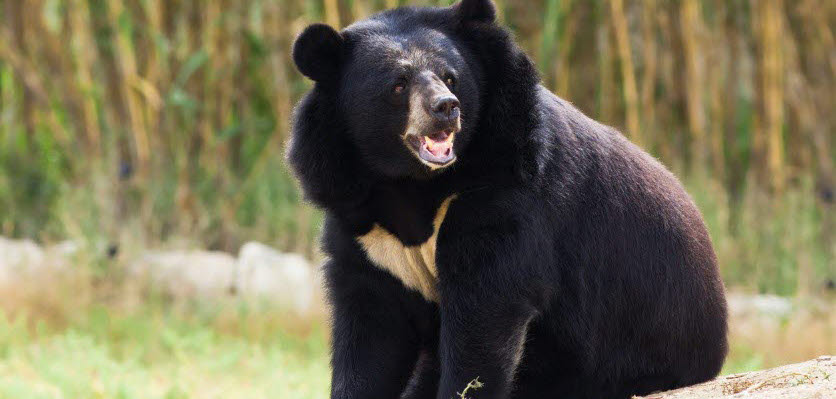
Every day, Australian veterinarians work hard to increase animal health and welfare standards, not just in our part of the world, but across the globe. Dr. Emily Drayton has been working with Animals Asia since 2014. She shares her experience of working at the organisation’s China Bear Rescue Centre in Chengdu, a safe haven for predominantly Asiatic black bears that have been rescued from bear bile farms.
I have been fortunate to work as a veterinarian at the China Bear Rescue Centre for over 3 years now.
My interest in joining Animals Asia, and particularly in the organisation’s work to end bear bile farming in China and Vietnam, started years earlier when I was a veterinary student. Sitting in the Webster lecture theatre at the University of Sydney, I was inspired by Animal Asia’s founder and CEO, Jill Robinson, as she shared her story and that of the bears. From that moment, I had a new ambition and direction for my veterinary career.
Our sanctuary is home to over 90 bears that have been rescued from bear bile farms across China. The bears, predominately Asiatic black bears, arrive from the farms in a truly broken state – their bodies are mutilated. Many have dirty, contaminated fistula tracts connecting to their gall bladders (a method used to obtain bile). Their teeth are often cut or shattered from bar biting, their limbs stunted from poor nutrition and a lifetime of cage confinement. Emotionally, physically and mentally, these bears come to us as damaged individuals. Witnessing and playing a role in their rehabilitation is hugely rewarding work and one that I am incredibly proud to be a part of.
The Asiatic black bear, or moon bear, is a vulnerable species and our organisation is working closely with the Chinese government, traditional Chinese medicine practitioners, and the public to raise awareness of the realities of the bear bile industry. Although bear bile has been used in traditional Chinese medicine for thousands of years, the practice of bear bile farming is relatively new, being introduced to China in the 1980s. Currently, there are estimated to be over 10,000 bears in bile farms across China and another 1000 bears suffering a similar fate in Vietnam.
With synthetic and herbal alternatives available, there is no need for bear bile farming and bringing an end to this industry will not only end a cruel and unnecessary practice but will also help protect remaining wild populations.
To date, Animals Asia has rescued nearly 600 bears from bile farms. At our sanctuaries, the bears find safety, compassion, and respect. Once rehabilitated, they are managed in large, mixed social groups. Although considered to be mainly solitary in the wild, our bears take great enjoyment from the company of their own species, many forming life-long bonds. Currently, we do not have the option to release the bears back into the wild. Despite their rehabilitation, many bears do not have the physical or mental capacity to thrive in the wild and poaching and a loss of natural habitat are ongoing threats to wild populations. Last year, however, we were able to rehabilitate a young moon bear that had been ensnared in a poacher’s trap. Following treatment, the bear, named Rainbow, was released back into the wild and this was a first for Animals Asia.
Managing an ageing population of ex-bile farm bears comes with its own unique challenges. Many of the bears are geriatric and suffer from severe arthritis and spinal disease. Managing their pain is a major part of my role. Here in China, there can be difficulties in sourcing medications, especially those that have become the mainstay of veterinary analgesia in Western countries. Learning how to use different medications in an effective and multimodal way to provide dynamic pain relief has been vital to my role as a veterinarian.
On arrival from the farms, the bears have significant damage to their gall bladders and surrounding tissue and often require full cholecystectomies. Even years after arrival, we still see the effects of bile farming on the hepatobiliary system. Liver and gallbladder tumours are prevalent, accounting for over 80% of the tumours we have diagnosed in our bears. Hypertension, cardiac disease, and eye conditions are also commonly seen and our department works closely with a range of specialists to provide timely diagnosis and appropriate medical treatment.
Living in China is different from anything I have known and has taken me way outside my comfort zone; but working with these amazing bears, alongside passionate and dedicated people, is a hugely rewarding experience. I feel fortunate that I chose a career in veterinary science because it has given me the opportunity to make a positive change. Through my work, I have met a vast number of people who are incredibly passionate about animal welfare. As we move toward a period of greater compassion and respect toward animals, I can think of no better profession to be a part of.
This article appeared in the August 2017 issue of the Australian Veterinary Journal
